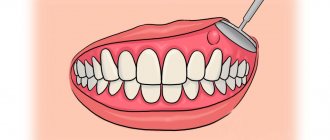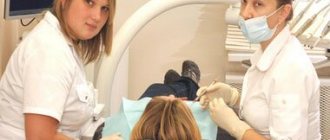Toothache can be caused by various reasons, including dental granuloma, which without proper and prompt treatment can lead to the tooth having to be removed. Therefore, you should never endure toothache, because only in a dental clinic can a dental granuloma be detected and treated.
What is a dental granuloma, what are its symptoms, does a granuloma require mandatory tooth extraction, and what methods are used to treat it in modern dentistry? All these questions will be answered by the material on our website dedicated to the treatment of dental granuloma. What is it - tooth root granuloma?
Dental granuloma is the name of an inflammatory process that affects the connective tissue (periodontal) in the area of the root apex. With the development of inflammation, the structure of the periodontium changes and a dense sac is formed in it - a granuloma. The granuloma is so tightly attached to the apex of the tooth root that it comes out of the gum when the diseased tooth is removed only together with the tooth.
YOU NEED TO REMEMBER: Many people think that a dental cyst and a dental granuloma are the same thing. But that's not true. When a dental cyst forms, a sac also forms, but it is hollow and as the cyst develops it will gradually fill with purulent fluid. A granuloma is a dense sac of inflamed tissue. Also, a granuloma will differ from a cyst in its size. Dentists call granulomas formations up to 0.5 cm in diameter. If the formation has a larger diameter, it is already a cystogranuloma.
What does a dental granuloma look like?
The photos and x-rays that we post below will help you see what a dental granuloma looks like.
What causes dental granuloma: the main reasons
There are two main reasons for the formation of granulomas:
1. Untreated pulpitis or inflammation of the nerve of the tooth. With pulpitis, the infection penetrates the nerve of the tooth and if it is not treated, the nerve will die and the pain will stop for a while, but the inflammatory process will not. The infection will continue to spread and travel through the root canals to the root of the tooth. When inflammation begins at the apex of the tooth root, periodontitis occurs, one of the forms of which is dental granuloma.
YOU NEED TO REMEMBER: Very often on dental forums the question is asked: can a granuloma occur under a filling or crown, because the tooth seems to have been cured and the inflammatory process in it has been stopped? This question can be answered this way: if the tooth treatment was performed poorly, then a dental granuloma may well develop both under the filling and under the crown. If the dentist, when working with a tooth, does not remove all tissues affected by caries, the inflammatory process will continue to develop and sooner or later will move to the root part of the tooth.
2. The second reason for the formation of granulomas is the poor quality of root canal filling. This procedure is necessarily carried out when depulping a tooth and, if mistakes are made in it, a granuloma can also appear on a tooth with a removed nerve. The tooth canals must not only be thoroughly cleaned, but also be properly filled with filling material.
The cause of the occurrence and development of dental granuloma can be non-compliance with medical recommendations after complex dental treatment. For example, if during treatment the gums were injured and the dentist prescribed the patient a course of anti-inflammatory therapy and rinsing, and the person decided to ignore these instructions, the infection could get into the open wound and trigger the development of a granuloma.
Very rarely, granulomas occur after tooth trauma or after poorly performed orthodontic dental treatment.
YOU NEED TO REMEMBER: Often people choose dentistry for dental treatment based solely on the prices of services. This is wrong; you need to choose a clinic for the treatment of dental granuloma and other dental diseases according to other criteria - the level of equipment, the competence of the specialists working in it. Our dentistry in Moscow - VENSTOM - has created all the conditions for high-quality, painless and comfortable dental treatment!
Causes of granuloma
What causes dental granuloma? Among the main factors provoking the formation of a focus of inflammation, the following should be highlighted:
- treatment of pulpitis was carried out poorly (for example, tissues affected by caries were not completely removed);
- the dentist filled the root canals in violation of the rules of asepsis and antisepsis;
- the tooth was injured directly due to damage to the maxillofacial area, unsuitable orthodontic design or for other reasons.
Symptoms of dental granuloma
Dental granuloma is a rather insidious disease, since it can develop for many years and not show itself in any way. Therefore, in the early stages of development, a dental granuloma can only be detected in the dentist’s office, and not during an examination, but after an x-ray, on which the darkening characteristic of a dental granuloma in the area of the root apex will be clearly visible.
With chronic granuloma, pain in the teeth is an extremely rare occurrence, but sometimes when biting or chewing food, mild pain may appear in the area of the affected tooth, and the tooth may also ache noticeably after consuming hot food or drinks. These unpleasant sensations pass fairly quickly, but if you notice similar symptoms, it’s time to see a doctor for diagnosis and treatment of dental granuloma.
Why should chronic dental granuloma be treated urgently? It’s simple: sooner or later, chronic granuloma will turn into an acute form, which has bright and pronounced symptoms. In the acute form of dental granuloma, the following symptoms are noted:
- Strong pain. The pain of dental granuloma is excruciating and intensifies when biting the tooth;
- Swelling of the gums in the area of the tooth with granuloma;
- General weakness, increased body temperature.
What happens if you don’t see a doctor for treatment of dental granuloma during an exacerbation? The granuloma may return to a chronic form, but severe purulent swelling (flux) and other complications may also occur. Therefore, regardless of the form of the granuloma, its treatment must be carried out!
Diagnosis of granuloma on the tooth root
At the early stage of development of the disease, it will not be possible to notice any visual changes. The first signs of pathology become noticeable as the size of the infected area and the amount of pus increase.
To treat the disease with therapeutic methods, it is necessary to examine the affected area in detail: a complete picture of the granuloma must be obtained, which will allow one to detect key signs of the disease that differ from other diseases.
When suppuration occurs, the gums become very red and swollen, and pain appears, which can radiate to the head area in general and the ear in particular. This is the first symptom that should make you wary.
The following methods can be used to make an accurate diagnosis:
- use of classical x-rays;
- the use of radiovisiography or, in simpler terms, computer x-ray.
In the picture, the affected area looks like a dark spot with a clear border in the upper part of the tooth. The size of the spot indicates the following:
- 5-8 mm – the probability of having a dental granuloma is high;
- more than 8 mm – formation in the form of a cyst.
In rare cases, a large granuloma, up to 1.2 cm in size, may occur. Therefore, X-rays may not be enough for diagnosis: it is recommended to perform a biopsy of tissue cells from the area affected by the disease.
In most cases, granuloma is discovered during treatment of other dental diseases: the doctor may pay attention to increased swelling and swelling of the gums. In addition, the bone tissue near the top of the tooth may also bulge.
An increased risk of developing granuloma is observed in patients with crowns and pulpless teeth. Such people are advised to undergo regular examinations in order to promptly identify any changes affecting the gums and teeth.
Tooth granuloma: what to do?
If, based on some signs, you suspect that you have a dental granuloma, make an appointment with your dentist as soon as possible. Treatment of granuloma should only be carried out by a specialist! We will explain in detail below why you should not self-medicate.
Why can’t dental granuloma be treated with antibiotics at home?
Antibiotics are used to treat dental granuloma - you can read about this on the Internet, on the websites of dental clinics. But under no circumstances should this information be taken as a direct guide to action. Firstly, you need to make sure that you have a dental granuloma and not some other disease, and secondly, you need to choose the right antibiotic.
In addition, just taking an antibiotic to treat dental granuloma is not enough - you need to treat the root canals of the tooth, and this cannot be done at home.
Will folk remedies help with granuloma?
Experimenting with folk remedies for dental granuloma also risks your own health. You need to remember one very simple thing: no decoction, infusion or compress will remove or cure the inflammation located in the root part of the tooth. Treatment of dental granuloma can only be carried out by a dentist, who should be contacted if you have symptoms of this disease!
Granuloma between tooth roots: treatment with antibiotics
The number of people putting off visiting a doctor until the last minute is large. There are many reasons for this: fear of pain (although modern means of anesthesia make it possible for the patient to feel nothing at all during treatment procedures), lack of free time, and reluctance to part with money. But all these reasons and excuses come to naught when the pain becomes unbearable, becoming chronic. As practice shows, as soon as a person does not sleep for a couple of nights, the issue of the need to visit the dentist is resolved by itself.
However, many people try to cure granuloma on their own using strong antibiotics, which is basically impossible. Antibiotics may be prescribed to relieve inflammation and stop the formation of pus, but nothing more. But the action of antibiotics may not affect pathogenic microorganisms located in the root canals, and it is the infection in their unsealed areas that is the only reason for the formation of granulomas.
If a patient comes to the doctor with a suspicion of granuloma, and the doctor, driven by some of his own considerations, does nothing, recommending taking antibiotics, it is better not to delay time, but to immediately contact another dentist. Some doctors simply do not like to re-treat someone’s poorly treated teeth, since repeating the same operations takes much more time, while others, if the patient comes back again, do not want to admit that they made a mistake, which for them is tantamount to realizing their own lack of competence.
Treatment methods for dental granuloma: how dental granuloma is treated in dentistry
Treatment of dental granuloma usually involves conservative therapy, during which the tooth canals are treated, their temporary filling is carried out for up to 3 weeks, and only after the image shows the cessation of the inflammatory process of the tooth - permanent filling of the canals and restoration of the tooth with a filling.
But in some cases, when a dental granuloma is diagnosed, surgical treatment is performed. Usually, surgical treatment of a tooth with granulomas is resorted to when there is obstruction of the dental canals, the impossibility of unsealing the canals, the treatment of which was carried out previously and was of poor quality, when a crown is installed on the tooth, or when there is a pin in the tooth canals.
Below we will look in detail at all methods of treating granuloma and start with conservative therapy.
Scheme of therapeutic treatment of dental granuloma
Therapeutic treatment of dental granuloma can take place according to different scenarios, depending on whether the root canals of the diseased tooth were previously treated or not. Let's consider both options in detail.
Treatment of granuloma on a tooth whose canals have not been filled previously
1. The treatment area is anesthetized and waterproofed with a rubber dam.
2. Using a drill, the dentist removes old fillings and damaged tooth tissue, while gaining access to the canals, which must be carefully processed for high-quality treatment of dental granuloma.
3. The channels are expanded with special tools - files and washed with an antiseptic solution.
4. Further treatment regimen will depend on the size of the granuloma. If they are small, the canal can be filled immediately, but if the granuloma has managed to grow to 3-5 millimeters, a medicine is put into the tooth canals that destroys the infection and stops the inflammatory process. This material will remain in the tooth canals for 2-3 weeks, after which the patient comes to the dentist again.
5. At the second visit, a control photograph of the tooth with granuloma is taken, which shows whether the treatment gave the desired positive result or not. If everything is normal, the dentist removes the medicinal material and performs permanent filling of the tooth canals and restoration of the tooth with a photopolymer filling.
Treatment of granuloma on a tooth whose canals were previously filled
In this case, treatment of dental granuloma will begin with unfilling the canals and only then the doctor will perform all the manipulations that we described above. If there is a crown on a diseased tooth with granuloma, it will need to be removed before treatment. After the granuloma is cured, the tooth is again covered with a crown, but keep in mind that the old crown cannot be placed - a new prosthesis will have to be made.
If you want to cure granuloma, but would not like to spend money on replacing the crown, then you can consider the option of treating granuloma with surgery - root resection.
Complications after granuloma at the site of an extracted tooth
Lack of timely treatment and hope that the disease will go away on its own is fraught with serious consequences. Among the most common complications it is worth highlighting:
- development of periodontitis and further formation of a fistula;
- the occurrence of alveolitis is a consequence of the presence of an inflammatory process;
- formation of purulent flux;
- suppuration of the perimaxillary tissue;
- entry of pathogenic bacteria into the lymph nodes, from where they penetrate the cardiac system and internal organs (kidneys, liver and brain);
- development of facial asymmetry;
- the emergence of new foci of infection;
- infection of the body due to the penetration of pathogenic microorganisms into the blood vessels.
Timely removal of granuloma is a guarantee to avoid unpleasant health consequences.
Surgical methods for treating dental granuloma
There are several surgical techniques for treating dental granulomatosis. The specific treatment technology is selected based on the characteristics of the clinical case. Below we will briefly review all the options for surgical treatment of granulomas.
Treatment of granuloma with root resection surgery
During treatment, the tip of the tooth root is excised and removed along with the pathological tumor. The operation is carried out according to the following scheme:
- 1. The dentist will peel off the gum and cut out a section of bone from the diseased tooth to gain access to the tip of the tooth root.
- 2. The root tip is removed along with the granuloma.
- 3. Synthetic bone material is placed in the area of the removed bone and the wound is sutured.
The operation lasts about an hour and if we talk about the price of this option for treating dental granuloma, then the average cost of the service in Moscow will be 6-7 thousand rubles.
Hemisection
This option for surgical treatment of dental granuloma is chosen if the diseased tooth has a large number of roots and when it is not possible to save the tooth root affected by the inflammatory process. The operation is carried out in several stages:
- 1. The dentist will remove a flap of gum in the area of the diseased tooth.
- 2. He will cut out a small piece of bone tissue, after which he will remove the affected root, as well as granulomas.
- 3. Antiseptic treatment of the surgical wound is carried out, and then synthetic bone tissue or natural osteoplasty is placed into the cleaned cavity.
- 4. The wound is sutured and stitches are placed on it.
The treatment process ends with detailed consultation of the patient on postoperative care. Note that rehabilitation after treatment of dental granuloma using hemisection is quite long - it will take 1-1.5 months.
Removal of a tooth
Tooth extraction to treat granulomas is a last resort measure, which is resorted to only if other methods have not given the desired result. Tooth extraction in the treatment of granulomas is prescribed:
- In advanced cases, if serious complications occur;
- When forming deep gum pockets;
- If there is a large vertical crack on the tooth;
- With complete destruction of the tooth crown;
- When perforations form on the root of a tooth.
After tooth extraction, the patient is prescribed a course of antibiotics and anti-inflammatory drugs, and after the wounds have healed and the inflammation has completely stopped, the extracted tooth can be restored by implantation or prosthetics.
How does a dental root granuloma form?
The process of development of pathological formation includes 3 stages:
- Development of dental disease leading to complications. Progression of inflammation with the accumulation of pathogenic microorganisms in the dental pulp. The pathological process, developing in connective tissues, leads to cell death over time.
- Pathology continues to develop. The infectious environment ends up in bone tissue. The result of the process is the formation of a neoplasm that transforms into the described granuloma.
- Against the background of bone tissue detachment from the infectious focus, a compacted connective tissue capsule is formed in the local area. In the resulting environment, complicated inflammation occurs, which leads to the rapid proliferation of bacterial microorganisms. At this time, the tissue grows rapidly, bacteria turn into purulent mucus. When visiting a doctor at the current stage, the specialist diagnoses acute granuloma.
The disease significantly undermines the human immune system. As the pathology develops, the tooth begins to loosen - the roots of the element are exposed.
Periodontal pockets, pathological formations between the gum and dental tissue, can also lead to the development of the disease. The cause of cavities is hard tartar.
The pocket holds a lot of bacteria, which leads to the formation of a gap between the gum and the socket. It becomes a “transport” for infection that penetrates into the root of the tooth. Subsequent growth of tissue at the base of the tooth root and filling of the cavity with pus is a granuloma.
Should I treat or remove a tooth for granuloma?
In most cases, a tooth with a granuloma can be saved - for this purpose in modern dentistry there are a lot of effective techniques, most of which we discussed above. But it is natural that treatment should be done without extreme measures - it should not be postponed until the pain in the tooth becomes unbearable, and the cheek swells from swelling.
If you want to keep your teeth intact and healthy, you must remember one very simple rule - even the slightest pain, slight discomfort that occurs in the teeth when eating or on its own is already a serious reason to see a dentist! The sooner a granuloma is diagnosed, the higher the chances of saving your tooth!
Preventive measures
Prevention of the disease is complex. The actions of a person who wants to prevent the formation of granulomas require compliance with the following medical recommendations:
- Following the rules of personal hygiene (daily brushing of teeth, rinsing the mouth).
- Timely treatment of bleeding gums.
- Regular visits to the dentist (at least 2 times a year).
- Timely change of toothbrushes to prevent infection in the mouth.
- Attentive attitude to your own health - reaction to pain, discomfort in the oral cavity, timely contact with a specialist.
- Complete cure of dental diseases.
- Use of medicated toothpastes for preventive purposes.
- Regular rinsing of the mouth with herbal decoctions.
- Including foods that are sources of calcium and vitamins in your daily diet.
Urgent dental care for the development of purulent inflammation
We already wrote above that dental granuloma develops asymptomatically for a long time and this form is called chronic. But if a person experiences severe stress, catches a cold, a malfunction occurs in the immune system of his body - the granuloma will turn into an acute form, in which purulent inflammation can begin to actively develop. Its signs are excruciating pain that does not subside after taking pharmaceutical painkillers, swelling of the gums and cheeks, and increased body temperature.
Naturally, with such symptoms, you need to urgently contact the dentist to get emergency help. Treatment will depend on where the pus is located and accumulates:
- If the pus is in the granuloma itself, then assistance to the patient will consist of opening the tooth to ensure the outflow of pus through the root canals;
- If there is swelling on the gum and cheek, this indicates that the pus could go into the mucous membrane or periosteum and then the doctor will have to make an incision in the gum to drain it.
If you go to the dentist with a granuloma of a tooth that is completely destroyed, it would be advisable to remove such a tooth. But at the same time, it is important that the tooth extraction procedure is carried out efficiently and not only the tooth is extracted, but also the granuloma. If the tumor remains in the socket, alveolitis may develop - a rather serious and unpleasant complication.
If you have had a tooth with a granuloma removed, you must properly care for your teeth and oral cavity after this operation. You should:
- Temporarily stop drinking too hot food/drinks, alcohol, smoking;
- Avoid overheating and hypothermia of the body and for this purpose do not visit baths, saunas, swimming pools, be sure to dress according to the weather;
- Eliminate stress and physical activity;
- Eat soft and warm foods for a week, trying not to chew on the side of the jaw on which the extracted tooth was located.
Be sure to take all medications and carry out all procedures prescribed by your doctor! If, within 3-4 days after the removal of a tooth with a granuloma, pain and swelling do not go away, contact the clinic immediately. The persistence of pain and swelling may indicate that the inflammatory process continues for some reason.
After tooth extraction during the treatment of granulomas, prosthetics and dental implantation are carried out no earlier than six months later. Such a pause in treatment is necessary for the complete restoration of all tissues in the area of tooth extraction.
Prices for treatment of dental granuloma
It is impossible to name the price for the treatment of dental granuloma in absentia - you need to determine the method by which it will be carried out, and also take into account the number of root canals of the tooth. The more canals the dentist needs to process when treating granuloma, the higher the cost of the service will be for the patient.
In the article we will indicate the average price for the treatment of dental granuloma in Moscow, it amounts to 7-8 thousand rubles. But please note that this figure does not include unfilling of previously treated canals. In addition, treatment using a microscope or laser will be paid separately.
In order not to guess how much treatment for dental granuloma will cost you, the best thing to do is make an appointment with a dentist and get the most detailed advice on this issue from a specialist. At our VENSTOM dentistry in Moscow, you can get a consultation on the treatment of dental granuloma at any time convenient for you - to do this, just make an appointment with our doctors through the form on the website or by dialing one of our contact phone numbers!











